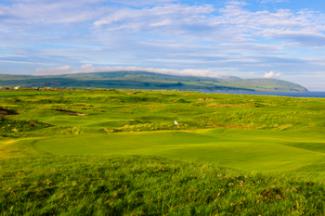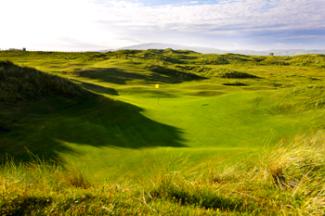Featured Golf News
Machrihanish Dunes - A Place Old Tom Would Savor
The flight from Glasgow, Scotland, to Campbeltown on the Kintyre peninsula is a brief 25 minutes. Yet it feels like a passage back to a time when Old Tom Morris was hitting a gutta-percha golf ball with hickory-shafted clubs on land that has resisted the winds of change for centuries.

The 6th Hole at Machrihanish Dunes
Old Tom, the patron saint of Scottish golf and a four-time champion of the British Open, played a role in designing the magnificent Machrihanish Golf Club that opened in 1876. He had no hand in Machrihanish Dunes, which staged its grand opening in July 2009. But those who make the pilgrimage to this dramatic, remote corner of Scotland are forgiven if they're convinced he did.
Machrihanish Dunes is the vision of Australian businessman Brian Keating, who fell in love with these windswept dunes while visiting the nearby Machrihanish Golf Club. Defying long odds, he set about creating a golf course. The result is a layout that was gently molded by David McLay Kidd, recognized worldwide for designing Bandon Dunes in Oregon and the Castle Course at St. Andrews. The opening was the culmination of a seven-year project.
The Kintyre peninsula is merely 35 miles as the crow flies from such hallowed golf destinations as Turnberry, Troon and Prestwick, and it's within sight of Northern Ireland. Yet the drive by car on picturesque A83 from Glasgow spans nearly three hours, down the long and winding road that served as the inspiration for one of Paul McCartney's most memorable songs. Although air is the quickest route, it can also be reached in one hour by ferry from Troon on the Ayshire Coast or from Ballycastle in Northern Ireland.

No. 9 at Machrihanish Dunes
"This is one of the few places on the British Isles where time has moved so very slowly," Kidd said. "Things haven't changed here in generations."
Even many Scots have never journeyed to this part of the world. "You're going where?" marveled a Scotsman whom I encountered in St. Andrews a few days before heading to Kintyre. "I've never ventured that far west."
The Machrihanish Dunes complex includes 23 luxury cottages overlooking the sea, the renovation of the adjoining Ugadale Hotel, and the restoration of the Royal Hotel set in nearby Campbeltown. The stone-faced Old Clubhouse - the original clubhouse of the Machrihanish Golf Club - also underwent a complete interior transformation.
Old Tom was never faced with the environmental restrictions that Kidd and his associate, Paul Kimber, encountered while constructing Machrihanish Dunes. As the first 18-hole golf course to be built on a "Site of Special Scientific Interest" on the west coast of Scotland in more than 100 years, the architects were required to fashion a layout while barely altering the natural landscape. Since 1980, all important coastal sites are protected by the SSSI designation.

The 13th Hole at Machrihanish Dunes
Machrihanish Dunes is home to a variety of rare orchids as well as rabbits and oyster catchers. That meant building a golf course without upsetting the fragile ecological balance. No chemicals or pesticides were allowed on the dunes. No heavy machinery was utilized. All portions of the land considered important were deemed off-limits.
A mere seven of the approximately 275 acres on which the course sits were disturbed during construction. Only the greens and trees were shaped, using a backhoe. Holes were designed around existing contours, while bunkers were placed where rabbits had eaten into the ground. Eighty Hebridian black sheep were brought in to provide assistance maintaining the rough and fairways from October through April. A silhouette of the sheep serves as the course logo.
"The ecologists helped us lay this one down lightly on the land, just as Old Tom Morris did on the neighboring Machrihanish course," Kidd said. "That's the way golf should be."
Pathways between holes meander over long stretches in a variety of directions, up and down hills, between the dunes, dictated by the lay of this precious, ecologically sensitive slice of land that sits hard by the Atlantic Ocean. There are extended, difficult walks, and course guides are essential if you hope to score.

No. 16 at Machrihanish Dunes
"Only one-third of the course is maintained grass, while two-thirds is protected forever," Kidd said. "Every green edge, every bunker edge, every fairway mow line required approval (from ecologists). To say we were light-handed and minimalist is an exaggeration."
Keating purchased the 300 acres of scrubland at Machrihanish in 2002 and immediately conducted an environmental study before presenting his plans to the Royal & Ancient Club of St. Andrews, the Scottish National Heritage (somewhat equivalent to the EPA in the United States), and a regional council. He also hired an ecologist to oversee the project. He then brought aboard Kidd, Kimber and Euan Grant, a former greenskeeper at St. Andrews.
There were times when the project appeared doomed. As ecologists imposed additional restrictions on how the course could be built, Kimber concedes, "I said to David (Kidd) on a couple of occasions, 'This just isn't possible.' "
"The building of the golf course was without doubt the easy bit," Kidd said. "The hard bit was understanding the fragility of the environment and being able to come up with a golf course design that was going to be acceptable to the environmental body. That was a two-and-a-half-year process, mapping out every last single detail of the site, figuring how can we wind a golf course through it.
"There was a huge degree of responsibility not to screw it up and to create something that was deserving of this incredibly special place."
The result is a links course with breathtaking views of the sea and the islands of Gigha, Islay and Jura. Six greens and five tees hover on the ocean's edge.
From a golfer's standpoint, the 7,175 yards of real estate require every bit of imagination and skill to play well. The ever-present howling wind, merciless rough, blind shots and severely undulating greens combine to present an ultimate test.
It's a golf course that blossomed from the rugged dunes - a modern-day links creation that pays homage to a past and would leave Old Tom Morris feeling right at home.
For more information, visit http://www.machrihanishdunes.com/.
This story originally appeared in Cybergolf on October 24, 2011.
Rob Duca is an award-winning sports columnist who wrote for the Cape Cod Times for 25 years, covering golf, the Boston Red Sox, the Boston Celtics and the Boston Bruins. He is now managing editor of Golf & Leisure Cape Cod magazine and has written for a variety of other publications, including Sports Illustrated, the Boston Globe, Yankee magazine and Cape Cod Life.
Story Options
 |
Print this Story |
